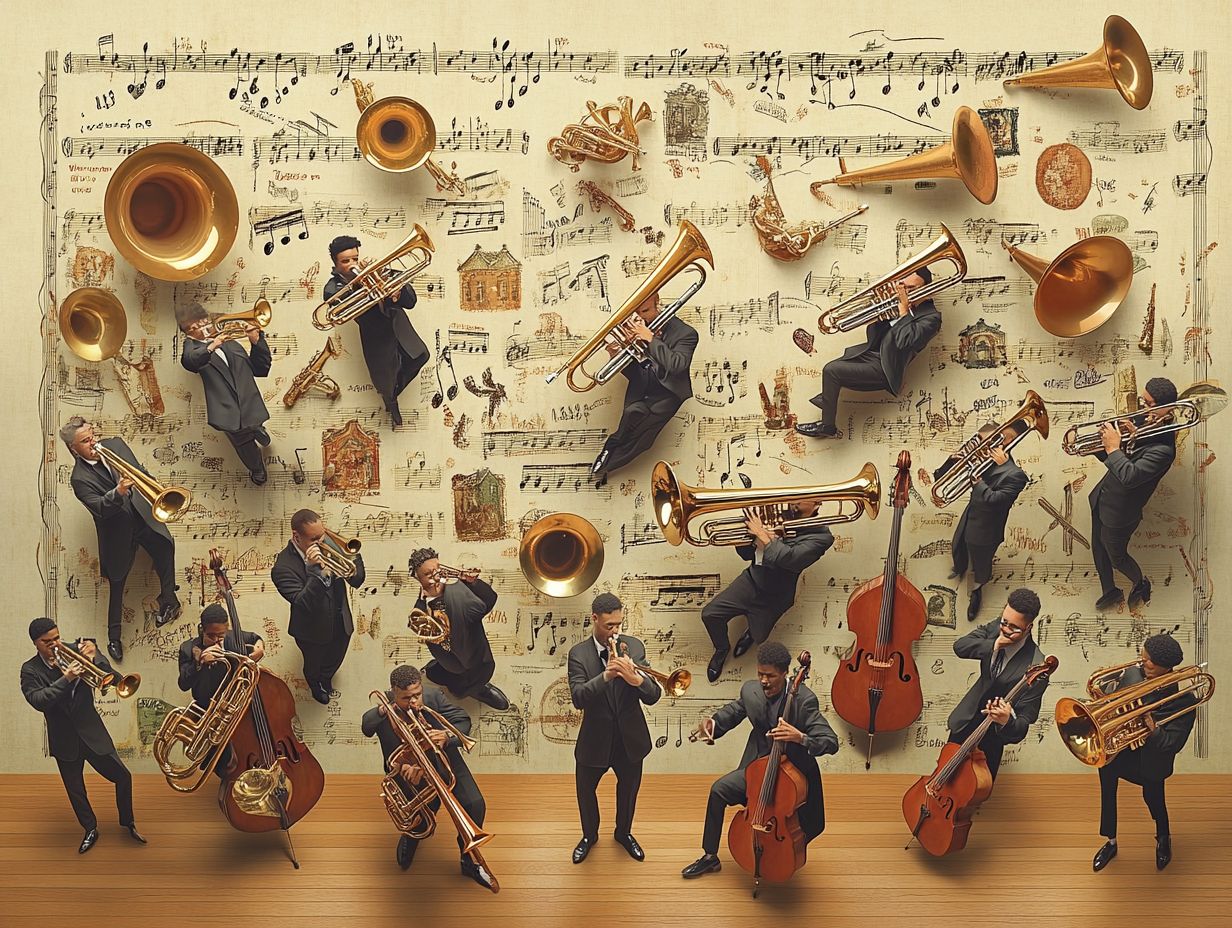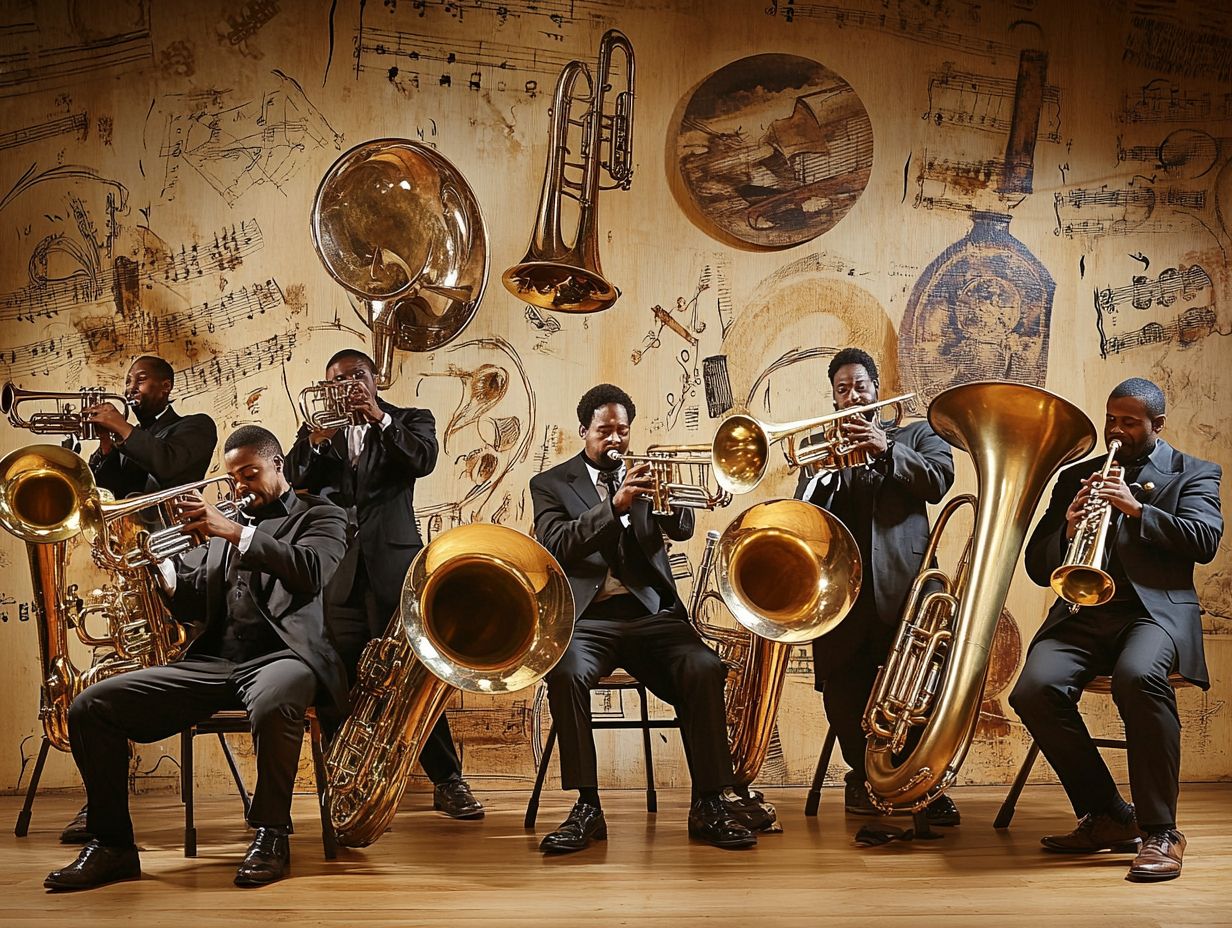Brass instruments have played a pivotal role in shaping the soundscape of music throughout history, from their ancient origins to their prominent positions in contemporary genres.
This article explores key moments and movements that highlight their influence, examining how trumpets and other brass instruments have evolved in classical, jazz, and pop music.
We will uncover the technological advancements that have transformed their sound and appearance, as well as their current usage and future trends, revealing the enduring legacy of brass in the ever-changing world of music.
Contents
The Role of Brass Instruments in Music History

Brass instruments have significantly influenced the evolution of music, from ancient cultures to the modern era, shaping the sound and dynamics across various musical periods. Throughout history, these instruments have played a crucial role not only in music but also in driving changes in culture and musical styles.
For example, trumpets have impacted orchestration in classical music and have been prominently featured in brass bands and marching bands, showcasing their versatility and importance in the transitions of music throughout history.
Key Moments and Movements
The evolution of brass instruments is marked by several significant moments and movements in history that underscore their versatility and importance in musical expression across various genres and styles.
The trumpet was a central element of Baroque ensembles, while the euphonium became a staple in military bands, and the trombone played a primary role in jazz big bands. These examples demonstrate the wide-ranging functions of brass instruments throughout musical history.
Pioneering musicians such as Louis Armstrong and Miles Davis revolutionized jazz by incorporating innovative brass techniques. Meanwhile, classical composers like Mahler and Beethoven harnessed the color and dynamic range of brass sections to enhance their symphonic works.
Contemporary artists such as Snarky Puppy and Dirty Loops continue to push boundaries by blending brass with electronic elements, showcasing the instrument’s long-lasting adaptability and enduring relevance in both traditional and modern musical contexts.
The Impact of Brass Instruments on Music Genres

Brass instruments have had a significant impact on various music genres, contributing to the sound of styles ranging from classical music to jazz and beyond. Their presence has enriched the diversity of music history.
From Classical to Jazz to Pop
Brass instruments have adapted to various musical styles, including classical music, jazz, and pop music.
In classical music, trumpets and trombones often perform bold fanfares and rich harmonies, showcasing their power and nuanced articulation. These instruments are prominently featured in orchestras and bands, providing strong melodic lines and harmonic support. The timbre of brass instruments can be altered using mutes, which can create a range of effects, from soft and mellow to bright and piercing.
In jazz music, musicians utilize techniques such as sliding notes and mutes to create expressive solos that drive the music forward. Jazz brass instruments like the trumpet, trombone, and French horn often play both melodic and harmonic roles within bands. Trumpets, in particular, are versatile instruments; renowned players such as Louis Armstrong and Dizzy Gillespie have employed various techniques, including lip buzzing and breath control, to generate a wide array of sounds—from bright and piercing to warm and mellow—depending on the mood of the piece. The freedom of improvisation in jazz allows brass musicians to explore new musical ideas and push the boundaries of the genre, leading to the development of unique sounds and styles and the emergence of new sub-genres and movements.
In pop music, brass instruments provide vibrant harmonies and melodies that enhance the catchy hooks and driving rhythms characteristic of the genre. They are commonly incorporated into arrangements for both vocal and instrumental pieces, helping to create a full and dynamic sound that elevates the overall appeal of pop music.
Advancements in Brass Instrument Technology

The advancement of brass instrument technology has significantly transformed the design and sound dynamics of these instruments, introducing innovations that enhance their acoustic properties and overall performance.
Innovations and Changes in Sound
Innovations in brass instruments have transformed their sound, enabling musicians to explore a broader range of tonal qualities and expressive techniques in their performances.
Advancements in materials, such as lightweight alloys and synthetic composites, have enhanced the resonating properties of these instruments, resulting in richer harmonics and improved projection.
Additionally, design techniques, including the use of variable bell shapes and precision-engineered mouthpieces, further enhance the instrument’s capacity to produce unique soundscapes.
These developments not only provide greater versatility in playing styles but also inspire performers to push their creative boundaries, experimenting with new techniques and incorporating a diverse array of genres into their repertoire.
Ultimately, these innovations are reshaping the auditory experience and deepening the connection between the artist and the audience.
Brass Instruments in Modern Music

Brass instruments remain widely used in modern music, showcasing their versatility and playing a significant role in various contemporary genres and styles.
Contemporary Usage and Influences
The contemporary use of brass instruments showcases their adaptability and significant influence on current music trends and genre shifts across the musical landscape. Whether in vibrant live performances or meticulously crafted studio recordings, these instruments provide a unique sonic quality that enhances various genres, including pop, jazz, and hip-hop.
Artists frequently blend traditional brass sounds with electronic elements, resulting in innovative combinations that resonate with modern audiences. This cross-genre experimentation not only revitalizes classic brass sounds but also inspires emerging musicians to explore new creative avenues.
Consequently, in today’s diverse musical environment, brass instruments play a pivotal role in enriching the fabric of contemporary styles and driving the evolution of genre-defying music.
The Future of Brass Instruments in Music
The future of brass instruments in music appears promising, as innovations will continue to evolve alongside cultural changes and music trends that influence their role in upcoming genres.
Trends and Predictions
There is currently a renewed interest in musical brass instruments, with predictions indicating that they will play an increasingly vital role in the future of music and various musical genres. This resurgence is evident in a diverse range of modern music movements, where artists are blending traditional sounds with contemporary genres, allowing brass instruments to take on a significant role.
For instance, genres like hip-hop and funk have shown a strong desire for brass integration, led by artists such as Trombone Shorty and the band Snarky Puppy. Their incorporation of trumpets and trombones not only enhances the melodic and harmonic structures of their arrangements but also infuses an energetic vibe that resonates with audiences.
As more musicians embrace brass sounds, new fusion genres are likely to emerge, potentially igniting a musical renaissance in composition styles.
Brass Fusion: A New Era
The Future of Brass Music: A New Era of Brass Fusion.
Brass fusion encompasses the blending of traditional brass musical styles with various other genres, allowing for experimentation and collaboration between brass musicians and instrumentalists or vocalists from different musical backgrounds.
